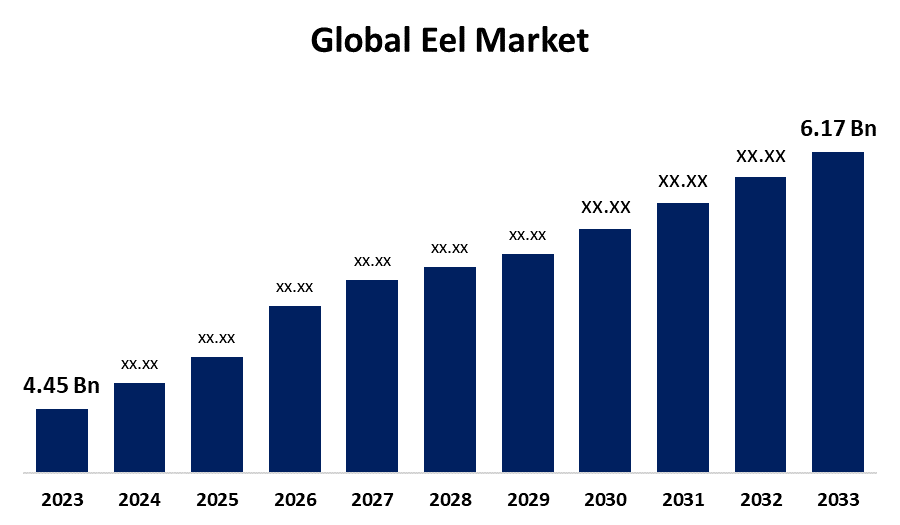Global Eel Market Size, Share, and COVID-19 Impact Analysis, By Type (Wild Eel and Artificial Raising Eel), By Application (Food Service, Retail, Food Processing), By Distribution Channel (Online Stores, Supermarkets/Hypermarkets, Specialty Store), and By Region (North America, Europe, Asia-Pacific, Latin America, Middle East, and Africa), Analysis and Forecast 2023 - 2033.
Industry: Food & BeveragesGlobal Eel Market Insights Forecasts to 2033
- The Global Eel Market Size was estimated at USD 4.45 Billion in 2023
- The Market Size is Expected to Grow at a CAGR of around 3.32% from 2023 to 2033
- The Worldwide Eel Market Size is Expected to Reach USD 6.17 Billion By 2033
- North America is Expected to Grow the fastest during the forecast period.

Get more details on this report -
The Global Eel Market Size was Worth around USD 4.45 Billion in 2023 and is Predicted to Grow to around USD 6.17 Billion By 2033 with a compound annual growth rate (CAGR) of 3.32% between 2023 and 2033. The global eel market is driven by growing demand for Japanese cuisine, health and nutritional benefits, sustainability and aquaculture advancements, and increased demand in Western markets.
Market Overview
The eel market is the international trade and consumption of eels, a species of long fish belonging to the order Anguilliformes. Eels are highly valued for their flesh, which is a delicacy in most cuisines, especially in Japanese, Chinese, and Korean food cultures. Eel is rich in omega-3 fatty acids, which are associated with a multitude of health benefits, such as enhanced cardiovascular health and mental acuity. Due to these reasons, eel has become quite sought after by health-conscious consumers. Moreover, the trend for sushi and Japanese foods such as unagi is one of the major drivers for the market of eel. Eel is one of the principal ingredients used in sushi, sushi rolls, and grilled foods, which are found to be widely consumed across the globe. Due to growing consumer interest in cardiovascular health and clean food, eel is promoted as a more health-friendly alternative to other fish and meat products, stimulating demand in health-conscious markets. Technological advances in sustainable aquaculture, including closed containment systems and recirculating aquaculture systems (RAS), have enhanced the efficiency and environmental sustainability of eel farming and enabled it to become a more sustainable alternative to meet rising demand.
Report Coverage
This research report categorizes the eel market based on various segments and regions forecasts revenue growth and analyzes trends in each submarket. The report analyses the key growth drivers, opportunities, and challenges influencing the eel market. Recent market developments and competitive strategies such as expansion, type launch, development, partnership, merger, and acquisition have been included to draw the competitive landscape in the market. The report strategically identifies and profiles the key market players and analyses their core competencies in each sub-segment of the eel market.
Global Eel Market Report Coverage
| Report Coverage | Details |
|---|---|
| Base Year: | 2023 |
| Market Size in 2023: | USD 4.45 Billion |
| Forecast Period: | 2023-2033 |
| Forecast Period CAGR 2023-2033 : | 3.32% |
| 2033 Value Projection: | USD 6.17 Billion |
| Historical Data for: | 2019-2022 |
| No. of Pages: | 230 |
| Tables, Charts & Figures: | 106 |
| Segments covered: | By Type, By Application, By Distribution Channel, By Region |
| Companies covered:: | V. GEITONAS& Co Ltd, Royal Danish Fish, Taishan Lvsheng Food Co., Ltd., Yamada Suisan Co., Ltd., Delaware Valley Fish Company, YONKYU, Scandinavian Silver Eel AB, Bos Seafood, S & J Fisheries, Foppen, and other key companies. |
| Pitfalls & Challenges: | COVID-19 Empact, Challenge, Future, Growth, & Analysis |
Get more details on this report -
Driving Factors
The global popularity of Japanese cuisine, especially sushi and unagi (grilled eel), also played a role in the much higher demand for eel products. Eel is rich in omega-3 fatty acids, which are required for heart health, brain function, and overall health. With consumers increasingly health conscious, eel is promoted as a heart-healthy food, driving the demand for the eel market.
Restraining Factors
Farm-bred eel is more costly to raise than a number of other fish species, limiting the demand for the eel market. Raising eels through aquaculture systems demands expertise, facilities, and capital to raise eels economically. Technologies such as recirculating aquaculture systems (RAS) assist in sustainability but can still be expensive, further restricting the demand for the eel market.
Market Segmentation
The eel market share is classified into type, application, and distribution channel.
- The artificial raising eel segment dominated the market in 2023 and is projected to grow at a substantial CAGR during the forecast period.
Based on the type, the eel market is divided into wild eel and artificial raising eel. Among these, the artificial raising eel segment dominated the market in 2023 and is projected to grow at a substantial CAGR during the forecast period. The growth is attributed to artificially bred or cultured eels being easier to manage in terms of breeding, feeding, and harvesting. This renders them more consistent in fulfilling consumer demand than wild eels, which are subject to seasonal fluctuations and tighter controls to avoid overfishing.
- The food service segment accounted for a significant share in 2023 and is anticipated to grow at a remarkable CAGR during the forecast period.
Based on the application, the eel market is divided into food service, retail, and food processing. Among these, the food service segment accounted for a significant share in 2023 and is anticipated to grow at a remarkable CAGR during the forecast period. The growth is driven due to eel is a component of traditional dishes like unagi don and is considered a premium food, with an association with fine dining. The rising popularity of Asian food around the world has propelled the demand for eels in food services beyond traditional markets.
- The supermarkets/hypermarkets segment accounted for the biggest share in 2023 and is anticipated to grow at a significant CAGR during the forecast period.
Based on the distribution channel, the eel market is divided into online stores, supermarkets/hypermarkets, and specialty stores. Among these, the supermarkets/hypermarkets segment accounted for the biggest share in 2023 and is anticipated to grow at a significant CAGR during the forecast period. The segmental growth is due to supermarkets and hypermarkets being the most convenient and prevalent locations where consumers buy eel, particularly in areas where eel is a staple food. These retail chains carry an assortment of eel products such as fresh, frozen, and processed eel, and they serve both ordinary consumers and consumers seeking more upscale alternatives.
Regional Segment Analysis of the Eel Market
- North America (U.S., Canada, Mexico)
- Europe (Germany, France, U.K., Italy, Spain, Rest of Europe)
- Asia-Pacific (China, Japan, India, Rest of APAC)
- South America (Brazil and the Rest of South America)
- The Middle East and Africa (UAE, South Africa, Rest of MEA)
Asia Pacific is anticipated to hold the largest share of the eel market over the predicted timeframe.

Get more details on this report -
Asia Pacific is anticipated to hold the largest share of the eel market over the predicted timeframe. The high Japanese demand for eel has driven a large share of the market. Both eels from wild and farm eels are consumed, but there is an increasing trend towards the farmed eel due to issues of sustainability as well as reducing wild eel availability. Eels in China are consumed across a wide range of culinary fare, while South Korea has an equally high popularity of eel consumption in conventional as well as contemporary cuisines.
North America is expected to grow at a rapid CAGR in the eel market during the forecast period. With the increasing popularity of sushi and other Japanese foods, with more consumers being introduced to traditional Japanese cuisine, eel consumption is on the rise in specialty restaurants and grocery stores. The presence of farmed eel, which is more sustainable and consistent in supply, is facilitating the fulfillment of this demand.
Competitive Analysis:
The report offers the appropriate analysis of the key organizations/companies involved within the eel market along with a comparative evaluation primarily based on their type of offering, business overviews, geographic presence, enterprise strategies, segment market share, and SWOT analysis. The report also provides an elaborative analysis focusing on the current news and developments of the companies, which includes type development, innovations, joint ventures, partnerships, mergers & acquisitions, strategic alliances, and others. This allows for the evaluation of the overall competition within the market.
List of Key Companies
- V. GEITONAS& Co Ltd
- Royal Danish Fish
- Taishan Lvsheng Food Co., Ltd.
- Yamada Suisan Co., Ltd.
- Delaware Valley Fish Company
- YONKYU
- Scandinavian Silver Eel AB
- Bos Seafood
- S & J Fisheries
- Foppen
- Others
Key Target Audience
- Market Players
- Investors
- End-users
- Government Authorities
- Consulting And Research Firm
- Venture capitalists
- Value-Added Resellers (VARs)
Recent Development
- In November 2024, Cell-based seafood pioneer Forsea revealed a significant breakthrough in establishing the production of freshwater eel meat from cells as a commercial reality. The start-up reported that its organoid technology achieved a record cell density of over 300 million cells/ml, with low and targeted utilization of cultured media ingredients.
Market Segment
This study forecasts revenue at global, regional, and country levels from 2023 to 2033. Spherical Insights has segmented the eel market based on the below-mentioned segments:
Global Eel Market, By Type
- Wild Eel
- Artificial Raising Eel
Global Eel Market, By Application
- Food Service
- Retail
- Food Processing
Global Eel Market, By Distribution Channel
- Online Stores
- Supermarkets/Hypermarkets
- Specialty Store
Global Eel Market, By Regional Analysis
- North America
- US
- Canada
- Mexico
- Europe
- Germany
- UK
- France
- Italy
- Spain
- Russia
- Rest of Europe
- Asia Pacific
- China
- Japan
- India
- South Korea
- Australia
- Rest of Asia Pacific
- South America
- Brazil
- Argentina
- Rest of South America
- Middle East & Africa
- UAE
- Saudi Arabia
- Qatar
- South Africa
- Rest of the Middle East & Africa
Frequently Asked Questions (FAQ)
-
1. What is the CAGR of the eel market over the forecast period?The global eel market is projected to expand at a CAGR of 3.32 % during the forecast period.
-
2. What is the market size of the eel market?The global eel market size is expected to grow from USD 4.45 Billion in 2023 to USD 6.17 Billion by 2033, at a CAGR of 3.32% during the forecast period 2023-2033.
-
3. Which region holds the largest share of the eel market?Asia Pacific is anticipated to hold the largest share of the eel market over the predicted timeframe.
Need help to buy this report?